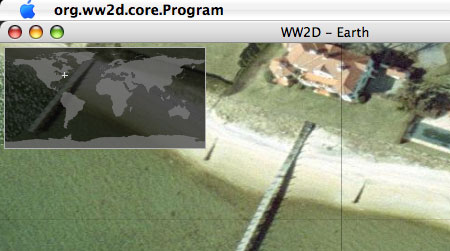I’ve been playing with WW2D, a cross-platform Java-based open-source Google Earthish application that works on OS X and Linux (and Windows), and here are some usage notes:
Installation is a cinch. Instructions are crystal clear. Whatever Java machine comes with OS X 10.4.3 works flawlessly.
Wait, this is Java??? WW2D is extremely responsive, even on my aging Mac, and the zoom controls are so fluid that I found myself zooming in and out far more often than I needed to. Image tiles are fetched from the internet on demand (much like Google Maps) but navigating the map is far faster and more responsive than any 2D web-based app I’ve used. It never crashed.
WW2D isn’t 3D, of course, so no tilting and no globe, but when you’re zoomed in close, it feels like Google Earth.
The data set is not bad. It renders the entire contents of Blue Marble Next Generation. Closer in, the world is covered by Landsat 7 imagery, which in many places is as good as Google Earth gets. In the US, you have access to the USGS imagery, which Virtual Earth uses. But the rarest (and most fun) is the layer labeled Aerial orthophotography. You don’t know if you get to see anything from this layer until you zoom in close, and there isn’t much available, but do start with Long Island, as it is covered in its entirety. Fire Island especially has some amazing villas on it:

The main downside vis-√Ü-vis Google Earth, other than the lack of 3D, is that while there are “add-ons” with additional data available for WW2D, there is nothing similar to the network link, and its absence makes you realize to what extent Google Earth’s usefulness is derived from it. Without the network link, you don’t really have a killer app (hence NASA World Wind’s relative obscurity).
WW2D’s GUI is a very sparse, but I came to regard this as a zen-like feature, not a bug. As long as there isn’t a 3D globe application out for the Mac, WW2D belongs on every Mac-owning map aficionado’s desktop, purely for its usefulness as a speedy Landsat 7 imagery browser. All the rest is a welcome bonus.
